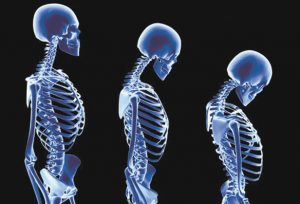By Sharla Gayle Patterson, MD, MBA
 Osteoporosis is a common bone disease that decreases bone mass and density, leading to an increased risk of fractures.
Osteoporosis is a common bone disease that decreases bone mass and density, leading to an increased risk of fractures.
It typically affects women after menopause, although it can also occur in men and women at any age. Osteoporosis is often called a “silent disease” because it can progress without symptoms until a fracture occurs.
The bones of people with osteoporosis become fragile and brittle due to a loss of calcium, phosphorus, and other minerals. This can lead to hip, spine, wrist, and other bone fractures. Fractures caused by osteoporosis can be severe and may require hospitalization, surgery, or long-term care.
Risk factors for osteoporosis include age, sex, family history, low body weight, smoking, excessive alcohol consumption, a sedentary lifestyle, and certain medical conditions, such as hyperthyroidism, Cushing’s syndrome, and inflammatory bowel disease. Some medications, such as glucocorticoids and anticonvulsants, can also increase the risk of developing osteoporosis.
Prevention and treatment of osteoporosis include lifestyle changes, such as regular exercise, a balanced diet rich in calcium and vitamin D, and avoiding smoking and excessive alcohol consumption. Medications such as bisphosphonates, hormone therapy, and denosumab can also be used to treat osteoporosis and reduce the risk of fractures.
Hormone replacement therapy (HRT) is a type of medical treatment involving replacing hormones deficient in the body. In the context of osteoporosis, HRT refers to the use of estrogen and sometimes progestin to prevent or treat bone loss in women who have experienced menopause.
During menopause, estrogen levels and other hormones decrease, leading to a decrease in bone density and an increased risk of fractures. HRT works by replenishing the body’s estrogen levels, which can help slow or even reverse bone loss.
There are two types of HRT: estrogen-only therapy (ET) and estrogen plus progestin therapy (EPT). ET is used for women who have had a hysterectomy (removal of the uterus), while EPT is used for women who still have a uterus.
HRT can be administered in several ways, including oral tablets, skin patches, gels, creams, and vaginal rings. The method of administration will depend on the individual patient’s preferences and medical history.
HRT can effectively prevent and treat osteoporosis, as it can increase bone density and reduce the risk of fractures. However, HRT is not suitable for everyone, and there are some risks associated with its use. These include an increased risk of blood clots, stroke, breast cancer, and heart disease.
Before starting HRT, a doctor will assess the patient’s medical history and risk factors to determine whether it is a suitable treatment option. If HRT is prescribed, it is typically used for a short period of time (usually 3-5 years) at the lowest effective dose to minimize the risks associated with its use.
HRT can be an effective treatment for osteoporosis in women who have experienced menopause. However, a doctor should carefully consider and monitor its use to ensure that the benefits outweigh the risks.
Preventing osteoporosis involves maintaining healthy bones throughout life by adopting a healthy lifestyle and taking steps to reduce risk factors. Here are some strategies that can help prevent osteoporosis:
1. Eat a balanced diet: A healthy diet that is rich in calcium, vitamin D, and other essential nutrients can help to build strong bones and prevent osteoporosis. Good sources of calcium include dairy products, leafy greens, and fortified foods. Vitamin D can be obtained from exposure to sunlight, fortified foods, and supplements.
2. Engage in regular exercise: Weight-bearing exercises, such as walking, jogging, and resistance training, can help to strengthen bones and reduce the risk of osteoporosis. Exercise can also improve balance and coordination, which can help to prevent falls and fractures.
3. Avoid smoking and excessive alcohol consumption: Smoking and excessive alcohol consumption can increase the risk of osteoporosis by interfering with the body’s ability to absorb calcium.
4. Get screened: Women over the age of 65 and men over the age of 70 should be screened for osteoporosis using a bone density test. People who are at higher risk for osteoporosis, such as those with a family history of the disease or who have experienced a fracture, may need to be screened earlier.
5. Take medications if necessary: Medications, such as bisphosphonates and denosumab, can treat osteoporosis and reduce the risk of fractures in people at high risk. These medications should only be used under the supervision of a doctor.
Magnolia Breast Center – The Trusted Choice for Breast Cancer Screening, Diagnosis, and Treatment in Southwest Florida Breast cancer is a serious, life-threatening disease that must be detected and treated as soon as possible. Whether you want to know your risk of developing cancer, get yourself checked for cancer, or get treated for cancer, the experts at Magnolia Breast Center can help you.
We have extensive experience in treating breast cancer patients – including highly complicated cases and patients with an advanced stage of cancer. We can determine the severity of your condition, take your unique needs and preferences into account, and devise a customized treatment plan to achieve a positive outcome.
Call our dedicated breast care center today at 239-758-PINK (7465) or contact us online and schedule an appointment with one of our experienced breast surgeons.
Magnolia Breast Center
3530 Kraft Rd, Suite 202, Naples, FL 34105
239.758.PINK (7465)
magnoliabc.com









